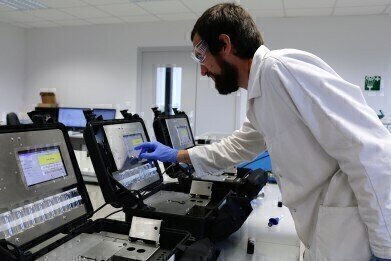Measurement and Testing
A New Approach to Onsite Fuel Stability and Compatibility Testing According to Automated Instrument ASTM D4740
Nov 21 2023
The marine fuel market is undergoing complex and far-reaching change, largely as a result of a growing body of environmental legislation. Issues surrounding fuel stability and compatibility have never been more relevant, especially in light of the new 0.10 per cent sulphur cap for fuels used in Emission Control Areas (ECAs).
Bulk fuel stored for long periods can become unstable – the asphaltene content can precipitate out of solution causing the formation of sludge. Once a fuel has chemically broken down there is no way to satisfactorily reverse the process. Precipitated asphaltene cannot be re-dissolved.
It is important to remember that a stable fuel oil can become unstable when mixed with another stable grade although generally fuels of the same viscosity grade with similar densities will be compatible.
On board a vessel, a good way to measure the compatibility of marine fuels, including residual and distillate fuels is the ASTM D4740 spot test. For the ASTM D4740 spot test a blend composed of representative volumes of the sample fuel and the blend stock is heated and homogenised. A drop of the blend is put on a test paper and heated to 100°C. After 1 hour, the test paper is removed from the oven and the resultant spot is examined for evidence of precipitation and rated for compatibility against D4740 reference spots.
AD Systems has developed a portable / on-site / on-board, fully automated instrument for stability and compatibility testing of heavy fuel oil. This patented portable device, the ST10, performs a complete automation of the ASTM D4740 method.
All the phases of the test are grouped in a suitcase, the conditioning of the samples, the preparation of the spot, its drying and the automatic rating by camera and associated software. The only phases carried out by the operator are the sampling and the deposition of the drop with the aid of a micropipette supplied with the equipment. The results are stored in a built-in result database. The image of the spot is memorised at the time the spot is rated. The ST10 ensures perfect traceability of the test. The AD Systems ST10 allows vessel operators to determine the compatibility of onboard fuels without the worry of the human eye subjectivity risk. As a result, the apparatus can be used anywhere by untrained personnel wherever and whenever power is available.
Digital Edition
PIN 25.3 June/July
June 2024
Analytical Instrumentation - Recent Advances In Various Bench Scale Accelerated Oxidative Testing Methods For Fuels - Petrochemical Industry: Anton Paar Solutions Streamline Processes, Reduce H...
View all digital editions
Events
Jul 30 2024 Jakarta, Indonesia
Jul 30 2024 Jakarta, Indonesia
China Energy Summit & Exhibition
Jul 31 2024 Beijing, China
Jul 31 2024 Chengdu, China
Aug 05 2024 Moon Township, PA, USA


















